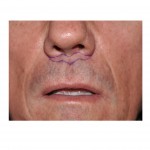Background: Aesthetic concerns of the lips are largely a gender specific issue. By far, most cosmetic lip procedures are done in women. Men represent a very small percent (1 to 2%) of those patients who undergo lip modifications, whether it is injectable fillers or excisional lip modifications.
The long upper lip is often viewed as an undesireable aesthetic feature. Some people have it naturally, others develop it with aging as the upper lip lengthens. In those that developed it with aging they most likely had a pre-existing marginally long upper lip. When the distance between the base of the nose and the bottom of the upper lip is excessively long, the upper teeth are hidden. Lack of upper tooth show, at lip rest or in smiling, conveys an aging appearance suggestive of edentulism which is common in the elderly. The long upper lip not only changes the ideal aesthetic facial height ratios and proportions but can subtly creates a more ‘animal-like’ mouth appearance. Many animals have very long upper lips for eating purposes which are not needed in humans.



The biggest trade-off of this simple lip excisional lift is that of a fine line scar at the base of his nose. It is initially red but fades within a few months. It remains well hidden in this nasal base-lip skin crease. One can expect some relaxation of the subnasal lip lift results usually up to 1/3 of the amount of vertical lip skin removed. (1 to 2 mms) For this reason, an extra 1 to 1.5mm of lip skin should be initially removed accounting for this eventual vertical relaxation. It is also important to realize that this type of lip lift only affects the central part of the upper lip and not the sides.
Case Highlights:
1) The long upper lip can be an aesthetic problem for men as well as women. Men are more concerned about the complete masking of the maxillary teeth, both at rest and in smile.
2) The subnasal lip lift design is the typical ‘bullhorn’ pattern. This is the same in men as in women. No greater than 1/3 of upper lip length should be removed.
3) The subnasal lip lift can be done in the office under local anesthesia. Men should refrain from shaving their upper lip for one week after surgery.
Dr. Barry Eppley
Indianapolis, Indiana


